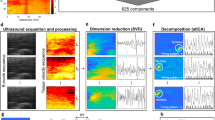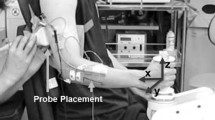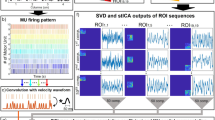Abstract
Accurate identification of contracting muscles can help us to understand the muscle function in both physiological and pathological conditions. Conventional electromyography (EMG) have limited access to deep muscles, crosstalk, or instability in the recordings. Accordingly, a novel framework was developed to detect contracting muscle regions based on the deformation field of transverse ultrasound images. We first estimated the muscle movements in a stepwise calculation, to derive the deformation field. We then calculated the divergence of the deformation field to locate the expanding or shrinking regions during muscle contractions. Two preliminary experiments were performed to evaluate the feasibility of the developed algorithm. Using concurrent intramuscular EMG recordings, Experiment I verified that the divergence map can capture the activity of superficial and deep muscles, when muscles were activated voluntarily or through electrical stimulation. Experiment II verified that the divergence map can only capture contracting muscles but not muscle shortening during passive movements. The results demonstrated that the divergence can individually capture the activity of muscles at different depths, and was not sensitive to muscle shortening during passive movements. The proposed framework can automatically detect the regions of contracting muscle, and could potentially serve as a tool to assess the functions of a group of muscles concurrently.






Similar content being viewed by others
Abbreviations
- sEMG:
-
Surface electromyography
- iEMG:
-
Intramuscular electromyography
- US:
-
Ultrasound
- DIP:
-
Distal interphalangeal
- PIP:
-
Proximal interphalangeal
- FDP:
-
Flexor digitorum profundus
- FDS:
-
Flexor digitorum superficialis
- RMS:
-
Root mean square
- fps:
-
Frames per second
- Def.:
-
Deformation
- Div.:
-
Divergence
References
Akhlaghi, N., C. A. Baker, M. Lahlou, H. Zafar, K. G. Murthy, H. S. Rangwala, J. Kosecka, W. M. Joiner, J. J. Pancrazio, and S. Sikdar. Real-time classification of hand motions using ultrasound imaging of forearm muscles. IEEE Trans. Biomed. Eng. 63:1687–1698, 2015.
Biały, M., W. Adamczyk, R. Gnat, and T. Stranc. Tissue deformation index as a reliable measure of lateral abdominal muscle activation on m-mode sonography. J. Ultrasound Med. 36:1461–1467, 2017.
Bogaerts, S., C. D. B. Carvalho, L. Scheys, K. Desloovere, J. D’hooge, F. Maes, P. Suetens, and K. Peers. Evaluation of tissue displacement and regional strain in the achilles tendon using quantitative high-frequency ultrasound. PLoS ONE 12:e0181364, 2017.
Bunce, S., A. Moore, and A. Hough. M-mode ultrasound: a reliable measure of transversus abdominis thickness? Clin. Biomech. 17:315–317, 2002.
Carpinella, I., J. Jonsdottir, and M. Ferrarin. Multi-finger coordination in healthy subjects and stroke patients: a mathematical modelling approach. J. Neuroeng. Rehabil. 8:19, 2011.
Castellini, C., G. Passig, and E. Zarka. Using ultrasound images of the forearm to predict finger positions. IEEE Trans. Neural Syst. Rehab. Eng. 20:788–797, 2012.
Chen, X., Y.-P. Zheng, J.-Y. Guo, Z. Zhu, S.-C. Chan, and Z. Zhang. Sonomyographic responses during voluntary isometric ramp contraction of the human rectus femoris muscle. Eur. J. Appl. Physiol. 112:2603–2614, 2012.
Chleboun, G. S., A. R. France, M. T. Crill, H. K. Braddock, and J. N. Howell. In vivo measurement of fascicle length and pennation angle of the human biceps femoris muscle. Cells Tissues Organs 169:401–409, 2001.
Debaere, F., D. Van Assche, C. Kiekens, S. Verschueren, and S. Swinnen. Coordination of upper and lower limb segments: deficits on the ipsilesional side after unilateral stroke. Exp. Brain Res. 141:519–529, 2001.
Gijsbertse, K., R. Goselink, S. Lassche, M. Nillesen, A. Sprengers, N. Verdonschot, N. van Alfen, and C. De Korte. Ultrasound imaging of muscle contraction of the tibialis anterior in patients with facioscapulohumeral dystrophy. Ultrasound Med. Biol. 43:2537–2545, 2017.
Gooch, C. L., T. J. Doherty, K. M. Chan, M. B. Bromberg, R. A. Lewis, D. W. Stashuk, M. J. Berger, M. T. Andary, and J. R. Daube. Motor unit number estimation: a technology and literature review. Muscle Nerve 50:884–893, 2014.
Guo, J.-Y., Y.-P. Zheng, H.-B. Xie, and X. Chen. Continuous monitoring of electromyography (emg), mechanomyography (mmg), sonomyography (smg) and torque output during ramp and step isometric contractions. Med. Eng. Phys. 32:1032–1042, 2010.
Kamavuako, E. N., D. Farina, K. Yoshida, and W. Jensen. Estimation of grasping force from features of intramuscular emg signals with mirrored bilateral training. Ann. Biomed. Eng. 40:648–656, 2012.
Kim, C.-Y., J.-D. Choi, S.-Y. Kim, D.-W. Oh, J.-K. Kim, and J.-W. Park. Comparison between muscle activation measured by electromyography and muscle thickness measured using ultrasonography for effective muscle assessment. J. Electromyogr. Kinesiol. 24:614–620, 2014.
Mademli, L., and A. Arampatzis. Behaviour of the human gastrocnemius muscle architecture during submaximal isometric fatigue. Eur. J. Appl. Physiol. 94:611–617, 2005.
McMeeken, J., I. Beith, D. Newham, P. Milligan, and D. Critchley. The relationship between emg and change in thickness of transversus abdominis. Clin. Biomech. 19:337–342, 2004.
Mogk, J. P., and P. J. Keir. Crosstalk in surface electromyography of the proximal forearm during gripping tasks. J. Electromyogr. Kinesiol. 13:63–71, 2003.
Nelson, C. M., W. M. Murray, and J. P. A. Dewald. Motor impairment-related alterations in biceps and triceps brachii fascicle lengths in chronic hemiparetic stroke. Neurorehabil. Neural Repair 32:799–809, 2018.
Perry, J., C. S. Easterday, and D. J. Antonelli. Surface versus intramuscular electrodes for electromyography of superficial and deep muscles. Phys. Ther. 61:7–15, 1981.
Revell, J., M. Mirmehdi, and D. McNally. Musculoskeletal motion flow fields using hierarchical variable-sized block matching in ultrasonographic video sequences. J. Biomech. 37:511–522, 2004.
Shi, J., J.-Y. Guo, S.-X. Hu, and Y.-P. Zheng. Recognition of finger flexion motion from ultrasound image: a feasibility study. Ultrasound Med. Biol. 38:1695–1704, 2012.
Shin, H., Y. Zheng, and X. Hu. Variation of finger activation patterns post-stroke through non-invasive nerve stimulation. Front. Neurol. 9:1101, 2018.
Simon, N. G. Dynamic muscle ultrasound-another extension of the clinical examination. Clinical neurophysiology: official journal of the International Federation of Clinical Neurophysiology 126:1466, 2015.
Simon, N. G., Y.-I. Noto, and C. M. Zaidman. Skeletal muscle imaging in neuromuscular disease. J. Clin. Neurosci. 33:1–10, 2016.
Smith, L. H., T. A. Kuiken, and L. J. Hargrove. Real-time simultaneous and proportional myoelectric control using intramuscular emg. J. Neural Eng. 11:066013, 2014.
Solomonow, M., R. Baratta, M. Bernardi, B. Zhou, Y. Lu, M. Zhu, and S. Acierno. Surface and wire emg crosstalk in neighbouring muscles. J. Electromyogr. Kinesiol. 4:131–142, 1994.
Stokes, I. A., S. M. Henry, and R. M. Single. Surface emg electrodes do not accurately record from lumbar multifidus muscles. Clin. Biomech. 18:9–13, 2003.
Thirion, J.-P. Image matching as a diffusion process: an analogy with maxwell’s demons. Med. Image Anal. 2:243–260, 1998.
van der Werff, R., S. O’Leary, G. Jull, M. Peolsson, J. Trygg, and A. Peolsson. A speckle tracking application of ultrasound to evaluate activity of multilayered cervical muscles. J. Rehabil. Med. 46:662–667, 2014.
Vercauteren, T., X. Pennec, A. Perchant, and N. Ayache. Diffeomorphic demons: efficient non-parametric image registration. Neuroimage 45:S61–S72, 2009.
Zheng, Y., and X. Hu. Reduced muscle fatigue using kilohertz-frequency subthreshold stimulation of the proximal nerve. J. Neural Eng. 15:066010, 2018.
Zheng, Y., and X. Hu. Elicited finger and wrist extension through transcutaneous radial nerve stimulation. IEEE Trans. Neural Syst. Rehab. Eng. 27:1875–1882, 2019.
Acknowledgments
This study was supported in part by the National Science Foundation (CBET-1847319).
Conflict of interest
The authors have no financial relationships that may cause a conflict of interest.
Author information
Authors and Affiliations
Corresponding author
Additional information
Associate Editor Joel Stitzel oversaw the review of this article.
Publisher's Note
Springer Nature remains neutral with regard to jurisdictional claims in published maps and institutional affiliations.
Electronic supplementary material
Below is the link to the electronic supplementary material.
Rights and permissions
About this article
Cite this article
Zheng, Y., Shin, H., Kamper, D.G. et al. Automatic Detection of Contracting Muscle Regions via the Deformation Field of Transverse Ultrasound Images: A Feasibility Study. Ann Biomed Eng 49, 354–366 (2021). https://doi.org/10.1007/s10439-020-02557-2
Received:
Accepted:
Published:
Issue Date:
DOI: https://doi.org/10.1007/s10439-020-02557-2




